Hi Everyone,

Good health is an undeniable universal desire. We all want to live healthy lives. Nobody wants to live an unhealthy life. However, being healthy comes at a cost for many. Who should bear the cost of maintaining our health?
Before I progress any further with this post, let us discuss the costs of being healthy. There are the direct costs of prevention, cure, and treatment. There are the costs of suffering from not being healthy. There are the costs of opportunities forgone because of poor health. There are opportunities forgone to prevent poor health. Some of these costs will need to be borne entirely by the individual and some of these costs could be borne be society.
Prevent, cure, or treat
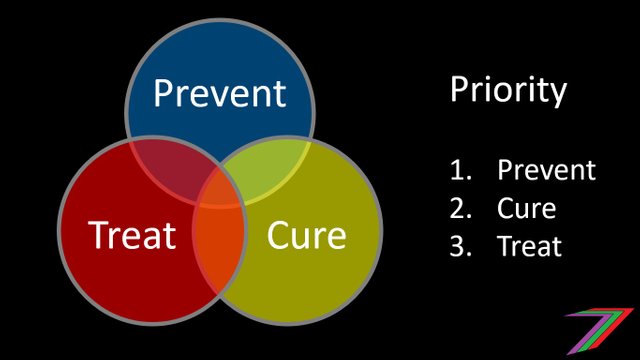
In my post Prevent, Solve or Manage, I discuss the approaches of prevent, solve, and manage. In the context of health, I will refer to these three approaches as prevent, cure, and treat. I believe the priority should remain as prevent, followed by cure, and finally followed by treat. The logic holds true that it is better not to be ill than be ill and recover and it is better to recover than needing to live with a medical condition. However, there are still many other factors to consider. These include probability of success of the approach, cost, and incentives of the provider.
Figure 1: Expected Cost of approach
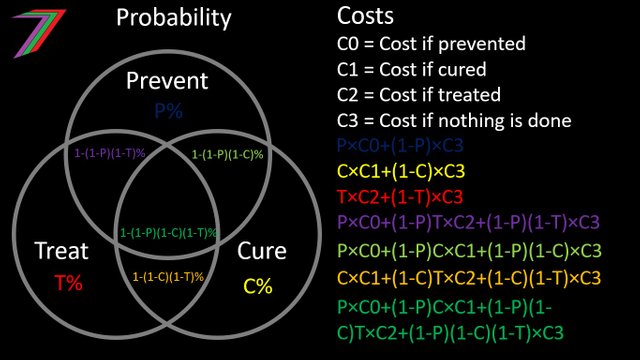
The expected cost is the sum of each cost multiplied by the probability of that cost occurring. A lower expected cost normally indicates a more favourable approach. A lower expected cost combined with a lower variance is even more favourable. The availability of multiple approaches would lower the variance of the cost.
I have touched on probability of success and cost. So far, I have not mentioned incentives to the provider. Incentives to providers is critical to understanding how a market solution might work. I will explain more later in the post.
Market Solution to Good Health
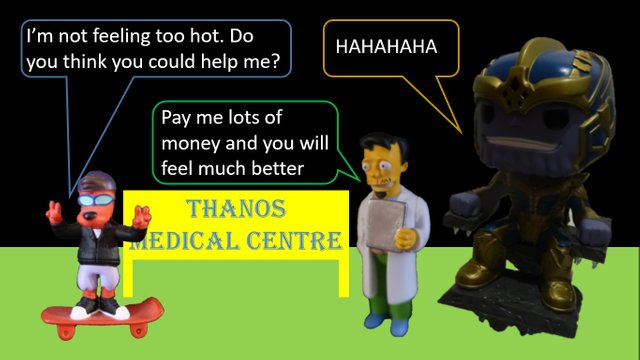
There is a possible market solution to providing good health. Healthcare can be considered a private good. It is excludable, i.e. you need to pay for it in order to obtain it. It is scarce, i.e. your consumption reduces the ability of others to consume it.
Many will argue that the market is not the best provider of good health as people who cannot afford to pay to obtain good health may need to settle for poor health. Not everyone is naturally gifted with good health. Some people have disabilities that can be very costly. A completely private solution will result in many people who have disabilities that require expensive treatments eventually not being able to afford these treatments.
Acquiring good health is different from acquiring a consumer durable such as a car. A person can buy a car and obtain a warranty. The warranty could cover manufacturer defects and faults that occur for the first X number of years or kilometres. A person does not buy their physical body, they obtain it at birth and it is determined by their genetic makeup or possibly some other complications. A warranty cannot be provided by the market, as a person has not obtained himself or herself through a market transaction.
Acquiring insurance is a possible market solution to maintaining good health. However, insurance does not work for people that have existing conditions and disabilities. Insurance companies would prefer to insure people who are not likely to fall sick. Insurance companies are profit motivated.
Private healthcare providers are also profit motivated. Healthcare is fundamentally the business of profiting from sick people. Customers are patients and products are cures and treatments. Treatments result in repeat customers and cures do not. Therefore, treatment is more likely to be the focus of the healthcare industry than cures. Prevention might be even less popular by the healthcare industry than cures as prevention could remove the customer entirely. However, this is not always the case; I will explain later in the post.
Public Funded Solution to Good Health
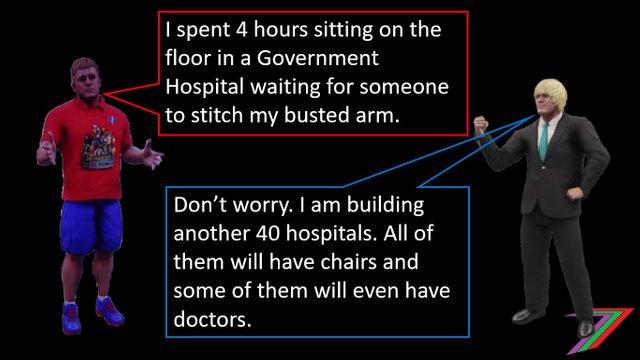
Healthcare in many countries is at least partly funded with public money. Governments build hospitals and clinics. They provide medical staff to attend to patients. They fund the technology and equipment necessary to diagnose illness and treat patients. They fund the purchase of medicines, vaccines, and other health products. They often provide funding to support medical research. Even if the Government very heavily funds the healthcare system, the private sector play some role in selling products, equipment, etc. to the health system.
There is no such thing as free healthcare. A publicly funded healthcare system may not charge a patient at the time they need medical care but the patient indirectly pays through taxation. If the patient does not pay tax or pays very little tax, the rest of society bears the cost of the medical care.
Are the Government best providers of healthcare?
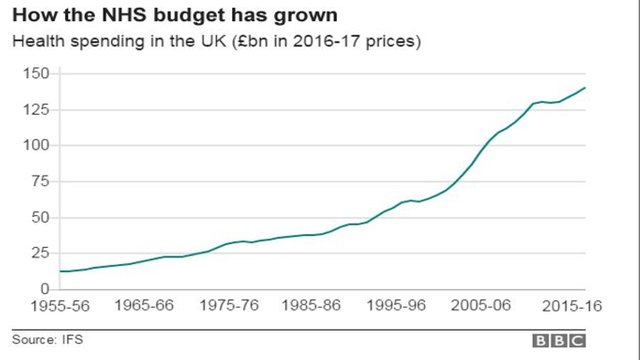
Any service or product provided by the Government is likely to be of a lower standard than if it is provided by the private sector. Government lacks the incentive to be efficient, as they do not need to be profitable to thrive or even survive. In fact, inefficiency is advantageous to many Government Departments as it enables them to obtain a higher budget. Healthcare is not likely to be any different. If the Government Healthcare providers are inefficient they will be granted more funds to compensate for their inefficiency. According to the BBC, the percentage of the United Kingdom’s public services budget spent on health has almost tripled since the 1950’s yet the system is failing to meet targets previously met with a lower budget.
How to solve the health problem (Prevention Approach)

The business model of providing healthcare is flawed. The business model should be around providing and maintaining good health. People want to be healthy. Therefore, the product should be good health. The focus should be on prevention and cure and not treatment. Let us use the example of a car. A car owner does not want his or her car to breakdown. Therefore, the car owner takes the necessary precautions to maintain the car. This could involve keeping it clean, checking and changing the oil, and taking the car for regular servicing. Likewise, a person does not want to fall ill. Therefore, the person should take the necessary precautions not to fall ill. This could involve eating healthy, staying active and not abusing themselves with harmful habits and addictions. We can move away from focusing on healthcare to facilitating healthy living.
There are existing markets for healthy living. The market provides healthy and nutritious food. The market facilitates an active lifestyle. The financial costs of healthy living can vary but often do not need to be excessive. According to webmd.com, a healthy diet (consisting mostly of whole foods) costs about US$1.50 more than an unhealthy diet (consisting of mostly processed foods) each day per person. I would not expect most western countries to vary much from this US estimate. Having an active lifestyle does not need to be expensive either. We can adjust our lifestyle to be more active doing activities we had initially planned to do. We could use our free time to enjoy activities that are more energetic. If we want, we could buy sports equipment and gear or become a member of a gym but that is not a requirement to be active.
For some people healthy living has an additional cost. This cost is the loss of enjoyment or convenience from not living healthy. Many people enjoy the taste of fast or processed food. Many people like the convenience of the quick and easy preparation of this food. Many prefer to watch television than ride a bicycle or walk in the park. Some people even pay financially for an unhealthy lifestyle by smoking or consuming excessive amount of alcohol. Some people genuinely enjoy paying for an unhealthy lifestyle, while others suffer from addiction; to be covered in another post.
How effective is a healthy lifestyle at preventing someone from becoming sick? This quite a difficult question to answer because there so many different ways we can fall sick and there so many different factors that can influence our chances of falling sick. According Chiuve et al, there is an inverse relationship between having a healthy lifestyle and Coronary Heart Disease (CHD). Figure 2 shows the relationship established by Chiuve et al.
Figure 2: Heart Disease and Healthy Lifestyle
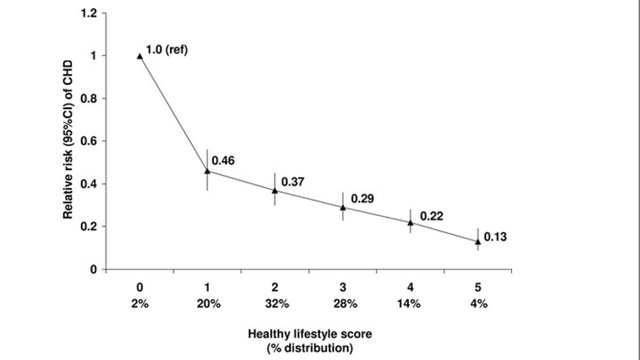
There is also evidence to suggest that a healthy lifestyle reduces the risk of cancer. Cancer Research UK links 13 different types of cancer to obesity. American Association for Cancer Research (AACR) consider more than 50% of cancer deaths as being preventable. Figure 3 shows what the AACR consider the highest contributors to cancer.
Figure 3: Cancer Risk Factors
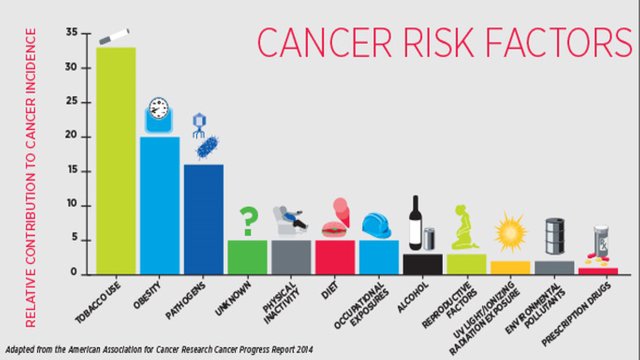
Heart disease and cancer are the number one and two causes of death in the world (Wikipedia). Both of these are preventable to a certain extant through healthier living.
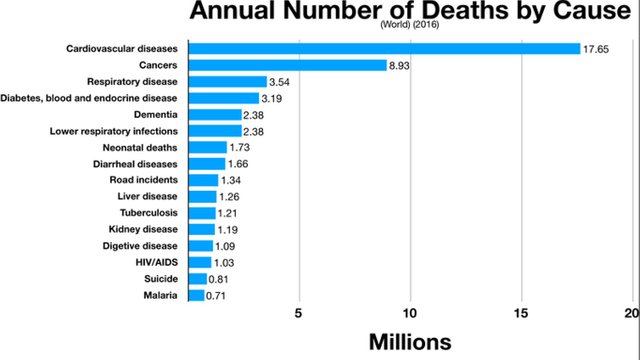
Having a healthier lifestyle is generally affordable and contributes to reducing illness and disease. The market provides healthier living solutions that do not require Government support.
Treatment vs. Cure
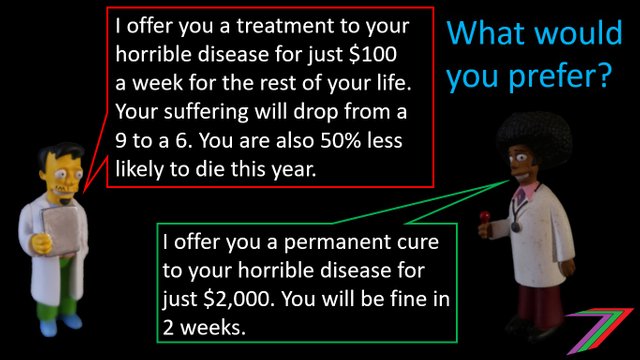
However good preventive measures might be, there will always be a risk of becoming ill. When that happens, the illness needs to be tackled. The approaches to tackling an illness or disease is cure, treatment or a combination of the two. Cure solves the problem (illness or disease). Treatment manages the problem. We can compare cure and treatment based on expected cost. Whichever has the lowest expected cost, can be considered the more desirable approach. As described earlier in the post, expected cost is based on probability of success and costs involved with both success and failure of a treatment and/or cure.
The market may not pursue the approach that has the lowest expected cost. The market will pursue the approach that generates the highest profit.
For the purpose of this post, I have created a hypothetical example of an imaginary disease. I have also assumed suffering from this disease can be quantified in dollars. The example is explained below.
Assumptions
Cost per day suffering (untreated) = $50
Price of weekly treatment = $20
Cost of weekly treatment = $10
Cost per day suffering (treated) = $30
Price of cure = $1,000
Cost of cure = $500
Duration of suffering with cure = 2 weeks
Probability of success of cure = 80%
Probability of success of treatment = 100%
If cure fails, treatment is used instead and remains 100% effective.
Calculations of Expected Costs
Expected Cost of cure approach (year one) = 1,000+50×14+0.2(20×50+30×350) = 4,000
Expected Cost of treatment approach (year one) = 20×52+30×364 = 11,960
Expected Cost of no action (year one) = 50×364 = 18,200
Calculations of expected profits
Expected Profit from cure approach (year one) = 1,000-500+0.2((20-10)×50) = 600
Expected Profit from cure approach (other years) = 0.2(20-10)×52 = 104
Expected Profit from treatment approach (year one) = (20-10)×52 = 520
Expected Profit from treatment approach (other years) = (20-10)×52 = 520
In the above example, the cure approach has the lowest expected costs to society in year one. The cure approach has the highest expected profit in year one. However, every subsequent year, the treatment approach has a higher expected profit. With the numbers used in the example, it would take approximately 60 weeks for the treatment approach to be more profitable than the cure approach. In the case of the example, firms are more likely to pursue the treatment approach than the cure approach.
It could be possible for new entrant firms to pursue the cure approach and take customers away from existing firms that are pursuing the treatment approach. However, the healthcare (pharmaceutical) industry is predominantly an oligopoly (market dominated by a few large firms, see my post Market Structure #4 - Oligopoly for an explanation of oligopoly). For an oligopoly market structure, it is very difficult for new firms to enter. An existing treatment approach will attract customers, as treatments are better than no action at all.
How to solve the health problem (Cure Approach)
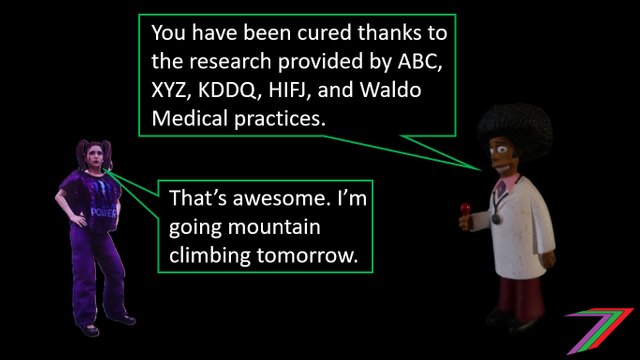
The oligopoly market structure for Pharmaceutical companies is likely to keep the private sector locked into providing and researching treatment instead of cures. Government funded healthcare relies on Pharmaceutical companies to provide them with medication. The existing large presence of Government in healthcare can be used to push money towards researching cures instead of treatments. Government can facilitate the growth of smaller companies that might be willing to pursue cures. There are smaller firms that specialise in natural remedies that are good alternatives to medical treatment. These firms should be allowed to compete for funding to enable growth.
Ultimately, the desire should be less involvement from the Government. Unfortunately, the private sector is too dominated by larger firms, which profit from treatment approaches. This dominance can be attributed to Government intervention that has enabled larger firms to grow through Government funding and the provision of patents. I believe open source research would greatly accelerate the growth of healthcare solutions (cures). For this to be possible, the market structure for healthcare needs to move away from an oligopoly market structure. An open source approach to medical research is discussed in detail by Roshan Paul & Alexa Clay.
Prevention and possible problems
In my post, A closer look at vaccines, I investigated vaccines. Vaccines should be considered as a prevent approach. However, what I found in my digging certainly raised many questions. Two areas of concern were the effectiveness of vaccines and the undesired affects they could be causing. I concluded that the evidence presented was inconclusive.
There is a lot of profit to be made from providing vaccines to the masses. There is also profit to be lost if the vaccines work too well and people do not fall sick and require treatment or cure. A best-case scenario for a Pharmaceutical company would be to profit from vaccines as well as from treating the problems that the vaccines are causing. Many of the diseases that vaccines claim to protect us from are not lifelong problems that require prolonged treatment (i.e. Measles, Flu, Mumps, etc). Whereas as the suspected negative effects are problems that are likely to require lifelong treatments (i.e. Autism, Bell’s Palsy, Multiple Sclerosis, etc). Actions of firms are often dictated by economic incentive rather than ethics or morals.
Summary
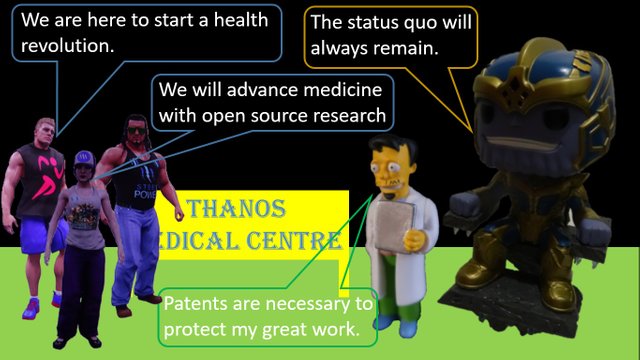
Health is something that affects everyone. Providing everyone with opportunities to live the healthiest life possible is a challenge. Both the public and private sectors have struggled to deliver the best health outcomes possible. The public sector are inefficient and often rely on products from the private sector. The private sector profit objectives do not align with best outcomes of society because of lack of competition and nature of an oligopoly market structure.
There are several possible ways to improve and maintain good health. The first and most obvious approach is to prevent disease, illness, and injury. The private sector can cater for prevention by providing healthy food at a reasonable price. Demand for healthy food is growing as people become more educated about which foods are healthy and how to maintain a good balance of different food groups. Remaining active is also achievable and generally affordable.
Making an effort to prevent disease, illness, and injury will not always be successful. Therefore, cures and treatments need to be available to tackle these problems as they occur. I believe the fastest approach to advancing medicine is through open source medical research. For this to be possible smaller firms and research groups will need to form. Incentives will need to be put in place to encourage cooperation. Domination of the market needs to stop and medical patents should no longer be granted.
To finish up this summary, I would like to reference the Venn diagram from my previous post, Prevent, Solve or Manage.
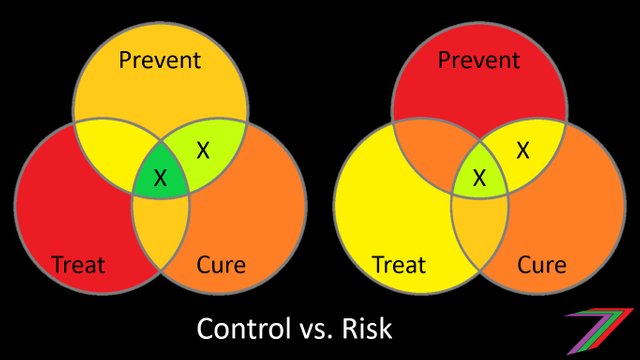
The areas marked by Xs represent what I believe should be the targets for all health problems. All health problems should have at least a method of prevention and cure. If the probabilities of success for prevention and cure are not high, a treatment approach could be added. However, a focus on prevention and cure should eventually render treatment unnecessary.
But who pays for healthcare?

I began the post with the question ‘Who should bear the cost of maintaining our health?’. I have partially addressed that question in regards to prevention, which involves us paying to maintain our own health through healthy living. However, who pays for treatments and cures. I have discussed how inefficient Government are at providing healthcare. I have discussed the problems of people with expensive healthcare needs not being able to pay to become healthy. If the health solutions discussed in this post are pursued, paying for healthcare will, in many cases, become less of a problem. However, it will always remain a problem for some.
A possible solution could be the blockchain and cryptocurrency. Instead of Government funding from taxes. Healthcare approaches could be funded from newly created cryptocurrency (inflation). How and who is funded could be determined through a decentralised process instead of Government bureaucrats. I will save this discussion for another post, which will be more focused on blockchain solutions to economic and social problems.
Formula used in Example
Costs
C0 = Cost if prevented
C1 = Cost if cured
C2 = Cost if treated
C3 = Cost if nothing is done
P = Probability of Preventing
C = Probability of Curing
T = Probability of Treating
Prevent Only Approach = P×C0+(1-P)×C3
Cure Only Approach = C×C1+(1-C)×C3
Treatment Only Approach = P×C2+(1-T)×C3
Prevent and Treatment Only Approach = P×C0+(1-P)T×C2+(1-P)(1-T)×C3
Prevent and Cure Only Approach = P×C0+(1-P)C×C1+(1-P)(1-C)×C3
Treatment and Cure Only Approach = P×C1+(1-C)T×C2+(1-C)(1-T)×C3
All approaches = P×C0+(1-P)C×C1+(1-P)(1-C)T×C2+(1-P)(1-C)(1-T)×C3
More posts

If you want to read any of my other posts, you can click on the links below. These links will lead you to posts containing my collection of works. These posts will be updated frequently.
Guide to the Steem Ecosystem (Udemy Course)

I have launched my Udemy course ‘Guide to the Steem Ecosystem’. This course takes you on journey through the Steem Ecosystem. The course consists of 6 sections. These sections are as follows:
- Getting Started
- Navigating Steem Frontends
- Becoming a Steem User
- Behind the Scenes
- The Wonders of the Steem Ecosystem
- Additional Content (SteemFest 4, SMTs, Communities, etc.)
The course contains 56 video lectures (about 13.5 hours of viewing), 56 multiple-choice questions (10 to 12 at the end of each section), and 59 downloadable resources (presentation slides and additional material such as white and blue papers). The course is free-of-charge. Click the link above to access the course.
I also have an economics course, titled Economics is for Everyone, which contains about 4 hours of video content.




Steem - The Future of DApps





Hi, thanks for the post! I included a link to it in my daily Science and technology digest, and you'll get a 10% share of that post's rewards.
Downvoting a post can decrease pending rewards and make it less visible. Common reasons:
Submit
Hey that's awesome, thank you.
Downvoting a post can decrease pending rewards and make it less visible. Common reasons:
Submit
a challenge for today's world to be healthy and productive lets see how this can help in a positive way :)
Downvoting a post can decrease pending rewards and make it less visible. Common reasons:
Submit
I try my best to spread my knowledge.
Downvoting a post can decrease pending rewards and make it less visible. Common reasons:
Submit
Congratulations @spectrumecons! You have completed the following achievement on the Steem blockchain and have been rewarded with new badge(s) :
You can view your badges on your Steem Board and compare to others on the Steem Ranking
If you no longer want to receive notifications, reply to this comment with the word
STOPTo support your work, I also upvoted your post!
Vote for @Steemitboard as a witness to get one more award and increased upvotes!
Downvoting a post can decrease pending rewards and make it less visible. Common reasons:
Submit
Hi, @spectrumecons!
You just got a 1.42% upvote from SteemPlus!
To get higher upvotes, earn more SteemPlus Points (SPP). On your Steemit wallet, check your SPP balance and click on "How to earn SPP?" to find out all the ways to earn.
If you're not using SteemPlus yet, please check our last posts in here to see the many ways in which SteemPlus can improve your Steem experience on Steemit and Busy.
Downvoting a post can decrease pending rewards and make it less visible. Common reasons:
Submit
Hi @spectrumecons!
Your post was upvoted by @steem-ua, new Steem dApp, using UserAuthority for algorithmic post curation!
Your UA account score is currently 5.056 which ranks you at #1097 across all Steem accounts.
Your rank has improved 354 places in the last three days (old rank 1451).
In our last Algorithmic Curation Round, consisting of 92 contributions, your post is ranked at #9.
Evaluation of your UA score:
Feel free to join our @steem-ua Discord server
Downvoting a post can decrease pending rewards and make it less visible. Common reasons:
Submit